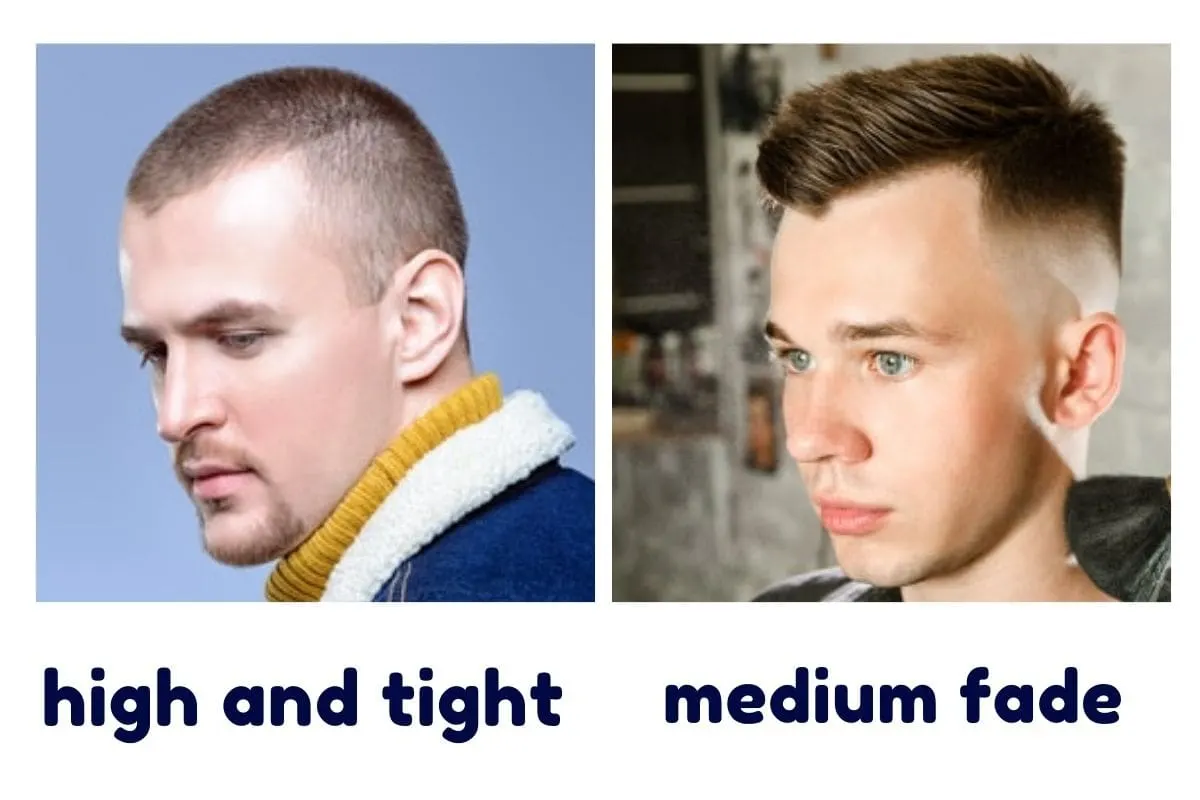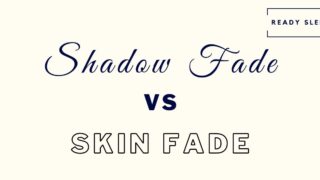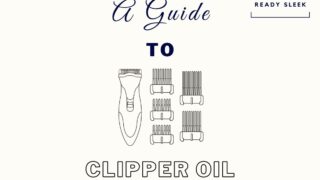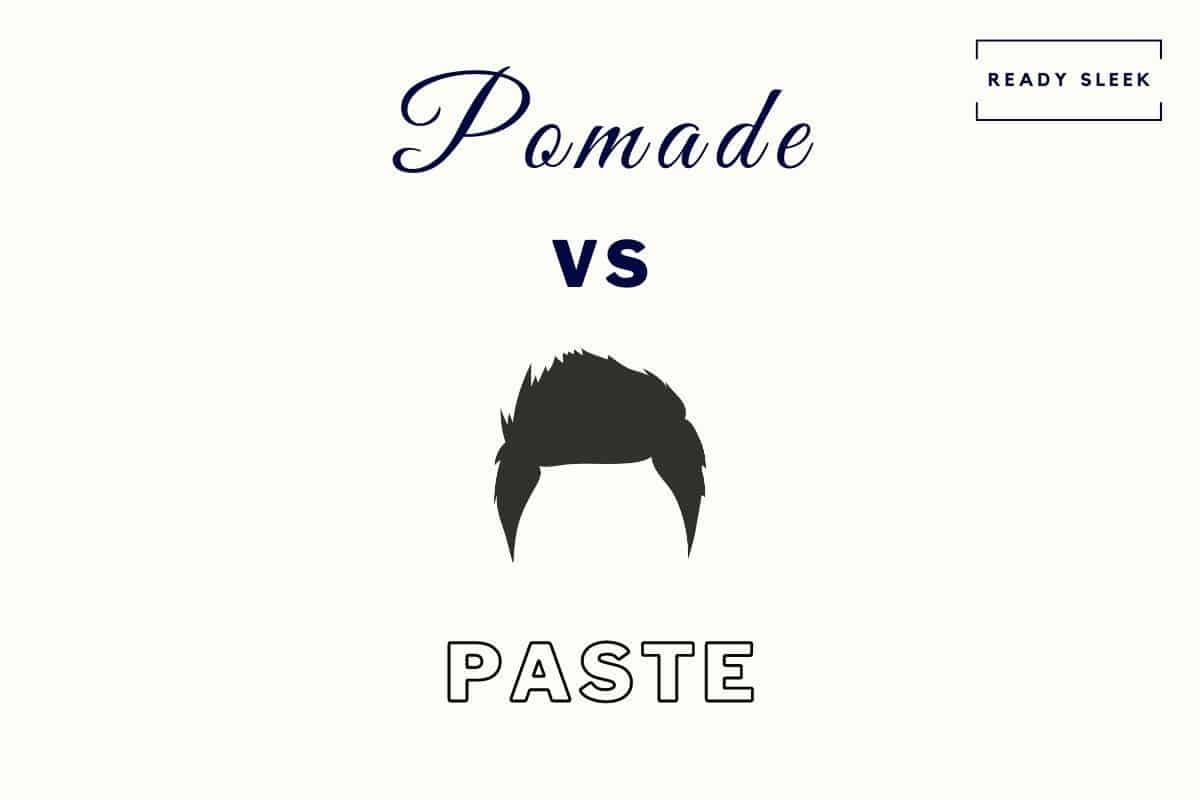The high and tight. It’s pretty much exactly what it says on the tin. What’s left to explain, right?
The problem is that it’s so similar to other styles that confusion is common.
That’s what I’m going to clear up right now.
First, I’ll explain exactly what it is using a photo to illustrate the points. Then, I’ll compare it to other similar styles that it’s often confused with – once again, using photos to really nail the point home.
Let’s get to it.
What Exactly Is The High And Tight?
The high and tight is a hairstyle where the sides and back are buzzed down very short or shaved completely up to a point above the temples. It then sharply transitions into longer hair on top without blending.

It’s the sharp transition from the very short or shaved sides up to the longer hair on top that gives it a bold and attention-grabbing appearance.
The lack of blending between the sides and the top leads to a harsh line at the border.
It gets its name from the way the sides, back, and top relate to each other.
The sides and back are shaved or kept very short up to a point above the temples – in other words, “high”.
The sharp line that divides the sides and back from the top is where it gets the “tight” portion of its name.
Although the top portion of the hair is longer than the sides/back, it’s still short – usually no more than 5-10mm long.
The style is a classic military hairstyle as it closely conforms to most of the strict regulations in place.
It has made its way into civilian culture and is known for its clean-cut, sleek, and intensely masculine appearance.
Buzz Cut Vs High And Tight
The buzz cut is a style where the hair is clipped down to an equal length in all directions. In contrast, the high and tight keeps the top hair longer than the sides and back which are shaved or clipped to stubble up to the temples.

The term “buzz cut” actually refers to a collection of styles that are all very short and dependent on the use of a clipper.
It includes “induction buzz cuts” where the hair is all an equal length, as well as “crew cuts” where the hair on top is left longer and often scissor cut.
It could be argued that the high and tight was actually a type of buzz cut.
Here we’re comparing the traditional induction buzz cut with the high and tight.
While the induction buzz cut has the hair at the sides, back, and top clipped down to the same length, the high and tight is known for the sharp contrast in length between the sides/back, and the top.
The sides and back of the high and tight may well be clipped down very short (buzzed). However, it’s the sharp contrast the sides and back have with the slightly longer hair on top that distinguishes it from the induction buzz cut.
The sides/back are left disconnected and non-blended with the top.
How To Choose:
Use the following points to help you choose between the high and tight and the buzz cut:
1. The induction buzz cut is simpler to DIY than the high and tight, considering you’re simply clipping everything down to the same length.
2. The high and tight is a little more interesting than the buzz cut given the difference in length between the sides and the top and the sharp transition between them.
3. If the sides and back of the high and tight are shaved (as they often are), you’ll need to maintain this over time. This does mean regular shaving of the sides and back which some men may not be willing to do.
Crew Cut Vs High And Tight
The crew cut has the hair on top upright and blended gradually into the shorter sides and back. The high and tight is different because the longer hair on top transitions sharply into the shorter sides without blending into them.

They do have some similarities but the differences are crucial to get to grips with.
With crew cuts, the hair on top is usually significantly longer than what you’d find with a high and tight where it usually doesn’t exceed 5-10mm.
The top hair of a crew cut is also usually longest at the front before graduating shorter as you go back.
Although both hairstyles benefit from the contrast between the longer hair on top and the shorter sides, this contrast is more marked and obvious with the high and tight.
The reason for this is that the transition from short to long occurs very high with the high and tight – usually above the temples.
In addition, there’s no blending between the sides and the top at the border. This leads to a sharp line here – you don’t get this with the crew cut.
With the crew cut, the transition from the shorter sides up to the longer top is more gradual, with blending and fading to soften any lines that you’d expect with a high and tight.
Crew cuts often have the sides faded or tapered, not shaved all the way up to the temples as you often find with high and tights.
Although both of these styles could be considered types of buzz cut, they have some significant differences that you should be aware of before asking for them at a barber shop.
How To Choose:
Without advocating for one over the other, here are some points you should consider when choosing between the crew cut and the high and tight:
1. High and tights usually don’t require any styling product considering just how short all of the hair is – even the top hair would be 10mm max.
With crew cuts, the top hair is usually longer and may often benefit from a bit of styling product to really keep it in check. If you’re not a fan of products, the high and tight may be for you.
2. The crew cut is a more subtle and understated style than the high and tight due to the blending and gradual transition from the sides up to the top.
Because the transition occurs so high up with the high and tight and that transition is so harsh, it’s often more eye-catching and obvious. If you’d prefer a more subtle style, go for the crew cut.
Undercut Vs High And Tight
The undercut consists of long hair on top that’s often slicked back and disconnected from the buzzed or shaved down sides. The high and tight is similar to the undercut in this respect but the hair on top is much shorter.

Although the styles share some things in common, they’re easy to distinguish from each other.
They’re both classic “disconnected” styles where the sides transition sharply into the top with minimal blending or fading.
So, there’s a harsh line at the border between the sides and the top with both of these styles.
However, with undercuts, the hair on top is considerably longer – usually long enough to slick back.
A common form of the undercut is where the hair on top is long enough to slick back and tie into a top knot.
Unlike undercuts, the hair on top is often clipped down very short. It’s just that the hair on top is longer than the sides and back which are often shaved down all the way up to the temples before they transition into the top.
It’s important to note that an undercut is more of a feature than an actual style itself. Yes – the hair on top is usually slicked back, but not always. It can flop forward into a fringe, sweep up into a pompadour – the options are endless.
What matters is that the hair on top is long and disconnected from the sides and back. If the style follows this formula, no matter what happens with the hair on top it can reasonably be called an undercut.
In contrast, the high and tight is not a feature and an actual style – you know exactly what to expect when asking for it.
When you’re asking for an undercut, however, you need to specify what you actually want to be done with the hair on top.
How To Choose:
1. The undercut is a lot more versatile than the high and tight given how long the hair on top is. You can style it in many different ways. If this appeals to you, the undercut may be a better option for you than the high and tight.
2. The high and tight is lower maintenance than the undercut when it comes to washing, drying, and styling. It’s so short that grooming it won’t take up any time at all.
3. The typical clean-cut appearance of the high and tight does make it a more “professional” looking style. If you’re looking for something more edgy and attention-grabbing, the undercut would be a better option.
Flat Top Vs High And Tight
The flat top has the hair on top standing upright, trimmed to form a flat deck appearance, and blended into the tapered sides and back. Unlike the flat top, the sides and top are not blended with the high and tight and left disconnected instead.

The flat top and the high and tight do have some similarities, but the differences should allow you to easily distinguish between them.
With the high and tight, the hair on top is very short – maximum 5-10mm usually. It may be longer than the shaved (or very short stubble) at the sides and back, but it’s still very short.
With flat tops, the hair on top is longer – long enough to stand upright and form a flat, horizontal platform appearance when viewed from the side profile.
This hair on top is usually blended gradually into the sides and not usually disconnected from them.
In contrast to the flat top, the high and tight has the shaved sides transitioning sharply into the hair on top at a point above the temples. In other words, the sides and top are disconnected, while the flat top is usually connected.
How To Choose
Choosing between the flat top and the high and tight? Consider the following points:
1. The flat top has largely fallen out of favor in recent years, with its heyday being in the 1950s and a brief resurgence in the 1980s. The high and tight has more of a timeless appearance to it – if trends are important to you it may be a better option.
2. The flat top can sometimes lead to an unusual appearance from the side due to the flat deck at the top. Taking face shape into consideration is important.
Medium Fade Vs High And Tight

Both Images From Shutterstock
A medium fade is a feature where the sides gradually transition from short to long at a point approximately two inches above the top of the ear. With the high and tight, the sides don’t gradually increase in length and instead transition sharply into the top.
A medium fade is not a style in itself. It’s a feature that can be incorporated into many different styles. In fact, all fades should be considered features and not styles.
What makes a fade a “medium fade” is the transition point of the fade. This is where the shortest length at the sides starts to blend into longer lengths as you go up toward the top.
The gradual change in length is what gives the fade its characteristic appearance.
But high and tights don’t gradually change in length like this. The sides are usually shaved all the way down to the skin, or at the very least buzzed down extremely short.
It’s just important to note that the length is the same all the way up the sides before sharply transitioning into the longer hair on top with no blending once again.
The hair on top is also short (5-10mm), but not as short as the super short sides and back.
The high and tight does not incorporate faded sides.
Unlike the medium fade, the high and tight is an actual style and not just a feature. It has a very specific appearance to it, while a “medium fade” can be included in hairstyles of practically any appearance.
How To Choose
When choosing between a medium fade and a high and tight, think about the following points before you make a decision:
1. The medium fade has a more subtle appearance to the sides than those of the high and tight. This is due to the tapering in length.
High and tights don’t taper the length and instead have all of the sides shaved down before transitioning sharply into the top. If you’re looking for something more subtle on the sides, a medium fade style may be more appropriate.
2. Fade styles are very popular, but some men are looking for a look that’s a little less common. The high and tight may be a better option for them.
Low And Tight Vs High And Tight
The high and tight is style with shaved sides disconnected from the slightly longer top. The low and tight is a misnomer and is not a real style, with people often incorrectly referring to a normal low fade style as a “low and tight”.
It’s important not to make this mistake. Getting the terminology right is important when communicating with your barber.
High and tights are real hairstyles with well-defined features. Low and tights – they don’t exist.
Conclusion
The high and tight is a classic hairstyle with a timeless appearance to it. There’s beauty in simplicity and the high and tight exemplifies that like few other styles do.
It has the benefit of being simple but still noticeable and quite eye-catching thanks to the disconnected appearance.
If you were thinking of choosing it as your style of choice, hopefully, this article has helped you ensure that you wouldn’t prefer a different, similar style instead.
Enjoy.
Ready Sleek founder. Obsessed with casual style and the minimalist approach to building a highly functional wardrobe. Also a fan of classic, vintage hairstyles.

![The High And Tight Vs 5 Similar Styles [Photo Comparisons]](https://www.readysleek.com/wp-content/uploads/2021/05/high-and-tight-vs-similar-styles-720x405.jpeg)





